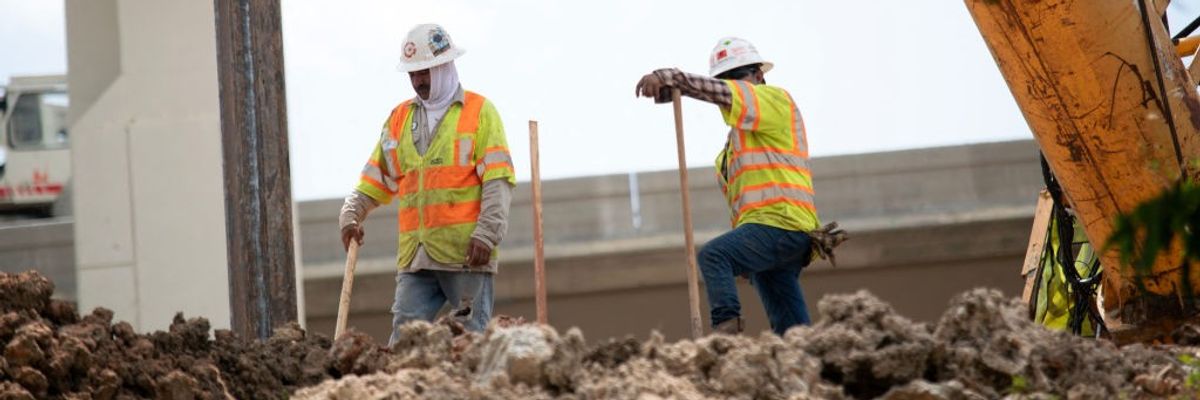In
Alabama, Arizona, Texas, and many other places, workers are getting sick and dying from extreme heat driven by climate change. In response, President Joe Biden announced on July 27 several measures to protect workers from extreme heat, including ramped up enforcement for heat safety violations and increased inspections in high-risk industries.
These actions are a modest step in the right direction—but this is no time for modest steps. The President, Congress, federal OSHA, and state and local officials must take bold action, now, to reduce risk and save lives.
We must urgently pursue decarbonizing our economy, with a fully funded just transition to ensure job and income security for affected workers. But workers cannot wait while this process unfolds. And we are not helpless in the face of the triple-digit temperatures that are breaking thermometers—and endangering workers—all over the globe. Heat stroke and heat illness, like other occupational hazards, are preventable.
Specific workplace safety standards, focused on the dangers of extreme heat, can offer more and better protection for workers, with a focus on training, abatement, and enforcement.
Practical,
evidence-based measures include adequate rest breaks, plentiful fresh water, and easy access to shade. In addition, reduced work schedules, moving work to cooler parts of the day, and a buddy system so no worker is left alone can and must be implemented in every indoor and outdoor setting where extreme heat is present.
There is no reason for employers to await the result of a regulatory process. There is definitely a reason
not to wait: Absent preventive measures, more workers will become sick and die from exposure to extreme heat.
In the legal arena, it is important to know that the currently existing “general duty” clause of the U.S. Occupational Safety and Health Act (OSHA) requires employers to provide a workplace free from known hazards, and that certainly includes the well-known hazard of extreme heat. Biden is on solid ground when ordering increased enforcement and inspections in the face of the current heat emergency.
But this
is an emergency, and much more can be done. Specific workplace safety standards, focused on the dangers of extreme heat, can offer more and better protection for workers, with a focus on training, abatement, and enforcement.
To that end:
- President Biden should order federal OSHA immediately to issue an Emergency Temporary Standard (ETS) to protect workers from heat stress. If workers dying after hours of laboring in the hot sun is not an emergency, what is?
- Congress should also act immediately and put into law a requirement that federal OSHA issue an interim standard on heat stress. This can complement and strengthen any emergency standard issued by the agency.
- Workplace safety officials in all states should take immediate steps to make sure their state-level standards on heat stress have broad reach and strong protections. The task is especially urgent in the 45 states with no current specific rules covering workplace exposure to extreme heat. State-level standards can frequently be completed more quickly than federal rulemaking, and under terms of the federal OSH Act, must be least as strong—and can be stronger—than federal standards.
- Municipal officials can and should also consider local ordinances which require rest, shade, water, and other measures for all affected workers in high-risk industries. In Miami, a campaign led by We Count (an affiliate of our organization, the National Council for Occupational Safety and Health) has brought together hundreds of farmworkers to demand a municipal heat ordinance which will offer protection to some 80,000 agricultural and construction workers.
Incredibly, the
state of Texas is moving in the opposite direction. City councils in Dallas and Austin have passed heat ordinances which require employers, among other things, to give construction workers 10-minute rest breaks every four hours during extreme heat conditions.
But the Texas state legislature recently passed the so-called “Death Star” law, signed by Gov. Greg Abbott. It will overturn these and other ordinances passed by democratically elected local officials. The new law goes into effect on September 1, at a time when temperatures will still be dangerously high in Texas.
The city of Dallas passed its heat protection ordinance in 2015, following the preventable death of Roendy Granillo. The 25-year-old construction worker died of heat stroke while installing hardwood floors on a site with no air conditioning during a heatwave in Texas in 2015.
His body temperature was 110°F when he died.
At our
National Conference on Worker Safety and Health in 2016, National COSH honored the Granillo family for their efforts to advocate for other workers following Roendy’s tragic death. The family was also featured in Building the American Dream, a film about the challenges facing immigrant families.
Now is the time to remember, not ignore, what happened to Roendy Granillo. And it’s time fight for the millions of workers who build our homes, bring food to our tables, and provide other essential goods and services. Record-breaking temperatures put those workers at risk right now. Our government, at all levels, must respond—right now.

